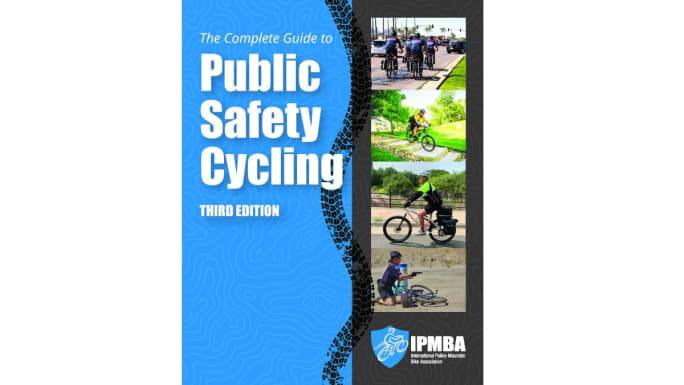According to the International Police Mountain Bike Association (IPMBA), mountain bikes have proven effective in a number of different environments. They are swift and agile in busy urban areas where traffic snarls and crowds delay motorized units. Bikes are also effective in less urban areas for park patrol, parking lots, campus areas, residential patrol, business security, athletic or civic events, and specialized details. They can be operated on streets, sidewalks, alleys, trails, and in any areas that are difficult to access with motor vehicles.
Why Bicycles are Great for Police and First Responders
Police and other first responders can use bicycles in a variety of ways. IPMBA shares a few examples of why they work so well in certain situations.

Representatives from the Delaware Police Department, Hilliard Police Department, Dublin Police Department , Powell Police Department, and Delaware County EMS gather for training.
Travis Ries/IPMBA
The advantages of using bicycles in public safety include:
• Bicycles can easily penetrate crowds – in highly congested areas police, EMS, and security personnel on bikes can move around more easily than patrol cars and ambulances.
• Response time in heavy traffic is improved – during their trial period in Orlando, bike medics responded in less than one minute 55% of the time; less than two minutes 83% of the time; and less than three minutes 95% of the time; contrasted with an average of four minutes for motorized rescue units.
• Stealth advantage – bicycles give officers the “stealth advantage” – because they are silent. Cops on bikes can ride right up to the scene of a crime before they are noticed.
• Police, EMS, and security cyclists lead by example – promoting helmet use and bike safety to the community and its children.
• Bicycles are great for public relations – an officer or a medic on a bike is much more approachable than one in a patrol car or ambulance.
• Bicycle use promotes good health – and departments benefit from decreased healthcare costs.
• Bicycles are enjoyable – even occasional bike duty improves morale.
• Bicycles are cost-effective – the average cost per bike is approximately $1200, a fraction of the cost of a cruiser, an ambulance, or any other motorized vehicle – and the annual maintenance costs are low.
• Bicycles are environmentally-friendly – no fossil fuels or emissions, and less parking surface is needed.
The IPMBA’s Complete Guide to Public Safety Cycling, third edition, is the only publication devoted exclusively to public safety cycling. It represents decades of experience and the collective expertise of hundreds of police, EMS, and security personnel who operate bicycles in the line of duty. Although they serve in many capacities, they all agree that, in the hands of a trained public safety cyclist, the bicycle is not just a mode of transportation-it is literally and figuratively a vehicle for delivering essential services to the community.
Written by members and friends of IPMBA, the Third Edition features new and expanded material, including:
• Bicycle Response Teams: A versatile, approachable crowd management team that responds quickly to crowd movements and changes in demeanor.
• Community Engagement: An essential aspect of public safety that can be enhanced by the accessibility of personnel on bicycles and through bicycle-focused initiatives.
• E-Bikes: A technology that has expanded patrol areas, enabled faster response times, and attracted additional public safety personnel to bicycle duty.
• Specialized Security: A field with a focus on routine patrol, rather than call-driven response, for which bicycles are ideal.
The most recent Complete Guide to Public Safety Cycling contains updated statistics, photos, figures, and examples of how public safety cyclists impact their communities as well as ways in which agencies can sustain and diversify their bicycle operations.

IPMBA has released the third edition of The Complete Guide to Public Safety Cycling.
IPMBA
More Patrol

Top 10 POLICE Videos of 2025
What were the top videos published by POLICE in 2025? Many covered tactics and officer safety, while others came from booth visits at IACP in Denver, Colorado. In case you missed these, here are the top 10 videos.
Read More →
Flock Safety and Coreforce Partner to Enhance Real-Time Awareness and Operational Efficiency for Law Enforcement
A new integration partnership will enable Flock Safety hotlist alerts and license plate recognition (LPR) searches directly in Coreforce’s Real-Time Crime Center (RTCC) and Digital Evidence Management System (DEMS) platform.
Read More →
Ballistic Armor Co. Secures Strategic Investment to Expand U.S. Production Capabilities
Ballistic Armor Co. secured a new commitment that will accelerate its multi-year transition from a third-party tactical equipment retailer to a premium innovator and U.S. manufacturer of advanced protective systems.
Read More →
Police & Fire Championships Expands Athlete Eligibility
The US Police & Fire Championships is now open to all employees – sworn, civilian, administrative, technical, and support staff – who work directly for an eligible public safety agency.
Read More →
Tips for Watching the Hands
How can officers better “watch the hands”? Mike Willis, Law Enforcement National Training and Program Director for the US Deputy Sheriff's Association, shares some tips.
Read More →
10 Tips for Felony/High-Risk Stops
What steps can officers take to stay safer during felony or high-risk vehicle stops? Here are 10 tips from Mike Willis, Law Enforcement National Training and Program Director for the US Deputy Sheriff's Association.
Read More →
Amped Highlights Power Behind Amped FIVE Software
Amped FIVE empowers you to advance your investigations with confidence and precision, from the crime scene all the way to the courtroom.
Read More →
Police K-9 Killed, Suspect Dies in Shootout with Cops
A Burbank Police Department K-9 was fatally shot over the weekend by a passenger who fled on foot from a traffic stop. The armed suspect was killed in a shootout with officers.
Read More →
From the Show Floor: InVeris
In this video, learn about how InVeris provides training to law enforcement, including customized augmented reality scenarios. The augmented reality system can scan up to 10,000 square feet of real-life environments and create a curriculum based on those spaces.
Read More →
From the Show Floor: Polaris Government & Defense
Learn about Polaris Government & Defense in this video as POLICE visits their show booth to discover their side-by-sides and the advantages they provide for agencies.
Read More →
